A well-maintained mower can be the difference between a largely hassle-free silage season or one spent running over and back to the local dealer.
We travelled to Clonbern in Co Galway to catch up with Patrick Dolan and Derek Raftery of P&D Agri Services at their new premises and get some tips for getting your trailed mower ready for the silage season.
The firm is an independent Case IH, New Holland and Kverneland specialist so many of the tips offered in this piece refer to Kverneland mowers, but most advice applies to all mowers.

Patrick Dolan (left) and Derek Raftery of P&D Agri Services.
1 Visual inspection
First off, the team would encourage a general walk around the mower to check for any issues and damage. Look closely for any leaks.
You may spot a small bit of weeping where oil might have started leaking over the winter. It is important to seal up these leaks before any oil is changed. Likewise, all oil levels should be checked over before the oil is changed.

The hydraulic hoses and fittings should be checked over for leaks, corrosion and damage.
If any of the oil levels are low, you need to ask yourself why. If all the oil levels are OK, the mower should be run for a short period. While running, a walk around and careful listen will help to flag and any initial issues.
Check over the slip clutch. Make sure it hasn’t seized over winter, and that it can be taken apart. Make sure the discs are not stuck to the steel. They can be sanded down and cleaned, but if the discs are black or burnt, replace them.
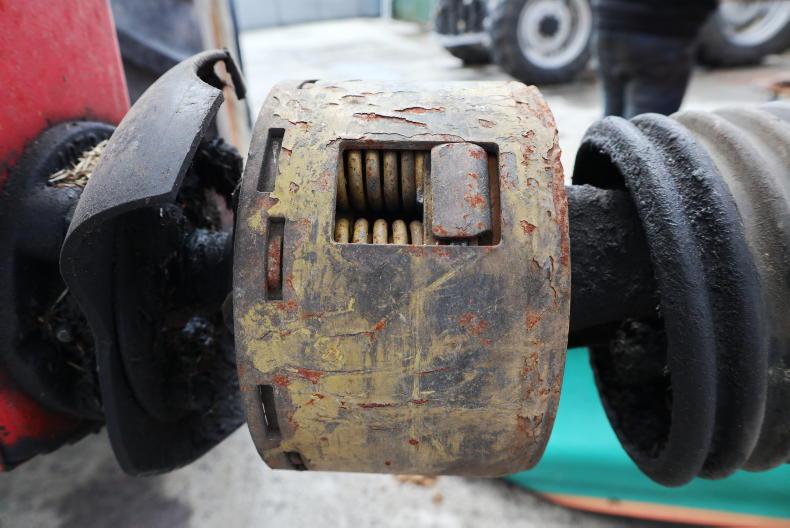
The slip clutch can be taken apart and the discs sanded down and cleaned, but if the discs are black or burnt, replace them.
2 Change oil
Change oil when it is hot. Check the oil for the presence of filings. If there are no filings present, refill as normal.
If there is a small amount of grit or filing in the oil, the team at P&D would advise flushing out the bed. This involves refilling the bed with an oil and diesel mixture and running it for a few minutes to loosen up any grit. It should easily flow out of the sump better than synthetic oil.

Change the oils when they are hot and check the oil for the presence of filings.
If there are excessive filings or grit in the system, the bed will need to be stripped down and power-washed. Grit is usually an indication of trouble with bearings.
Each mower and brand will vary but the lads fill a typical 10ft Kverneland mower bed with 4.1l of oil and a 9ft Kverneland mower with 3.6l of oil. They use GL75-90 gear oil.
It is very important not to overfill the mower bed with oil. The bed has no breather like a gearbox has. If you overfill the bed it will cause excessive heat. The oil level in the mower bed varies greatly from brand to brand so always refer to the operator’s manual or local dealer before starting this task. The oil change intervals for the cutting bed also vary from brand to brand.
3 The bed
The hubs should be checked for excessive play. A rocking in the hub will indicate bearing trouble. Check the stone guards for wear. If excessively worn they should be changed, otherwise they will only fall off in time.
The middle section is very important as it also protects the bed, especially in the case of a blade bending backwards. Stone guards are priced in the region of €85 to €107 plus VAT each.
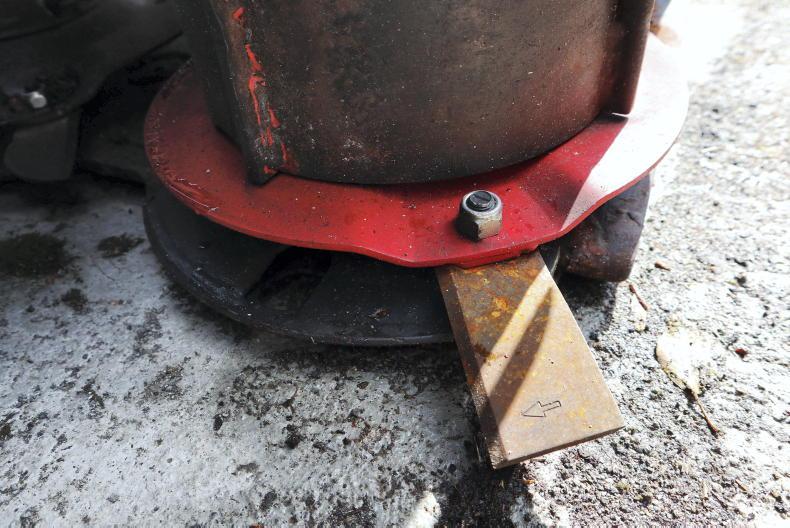
Rotate or replace damaged or worn blades as necessary.
The discs should be checked to ensure they are not excessively damaged or have chunks missing off them. They can be exposed to rock damage and wear so it is important to check them regularly.
Damaged discs may cause a vibration in the mower. Running a mower at such speed with vibrations will lead to further damage. Ensure the top hats are securely bolted on. Rotate or replace damaged or worn blades as necessary.
Finally, check over the bolts on the hangers that hold the bed on to the mower frame. It is held using five bolts each side. Check that the bolts are in good condition and are tight.
4 Conditioner
Firstly, check the condition of the two rotor bearings. The team at P&D say you will often find wire caught around these bearings. If the seal is damaged it is a tell-tale sign the bearing needs to be replaced. Also, if any rocking or play is evident, they will need to be changed. Make sure all the tines are present on the conditioner and none are bent or damaged.
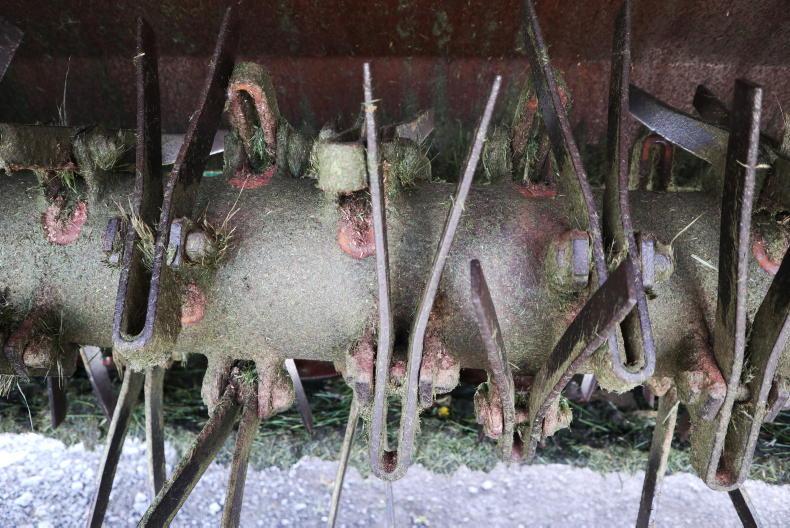
Make sure all the tines are present on the conditioner and none are bent or damaged.
Also, check for damaged or cracked hangers. If any hangers or tines are missing it will cause the rotor to run off balance and create unwanted vibration. Check the state of conditioner belts. If the belts are anyway hard or cracked, replace them. Otherwise, they won’t last very long when the pressure comes on.
5 Cutting at the correct height
Check the height adjuster for wear in the threads. Sometimes, the roll pin in the threaded bar can also break, meaning the bar will freely thread up and down but the cutting angle won’t change.
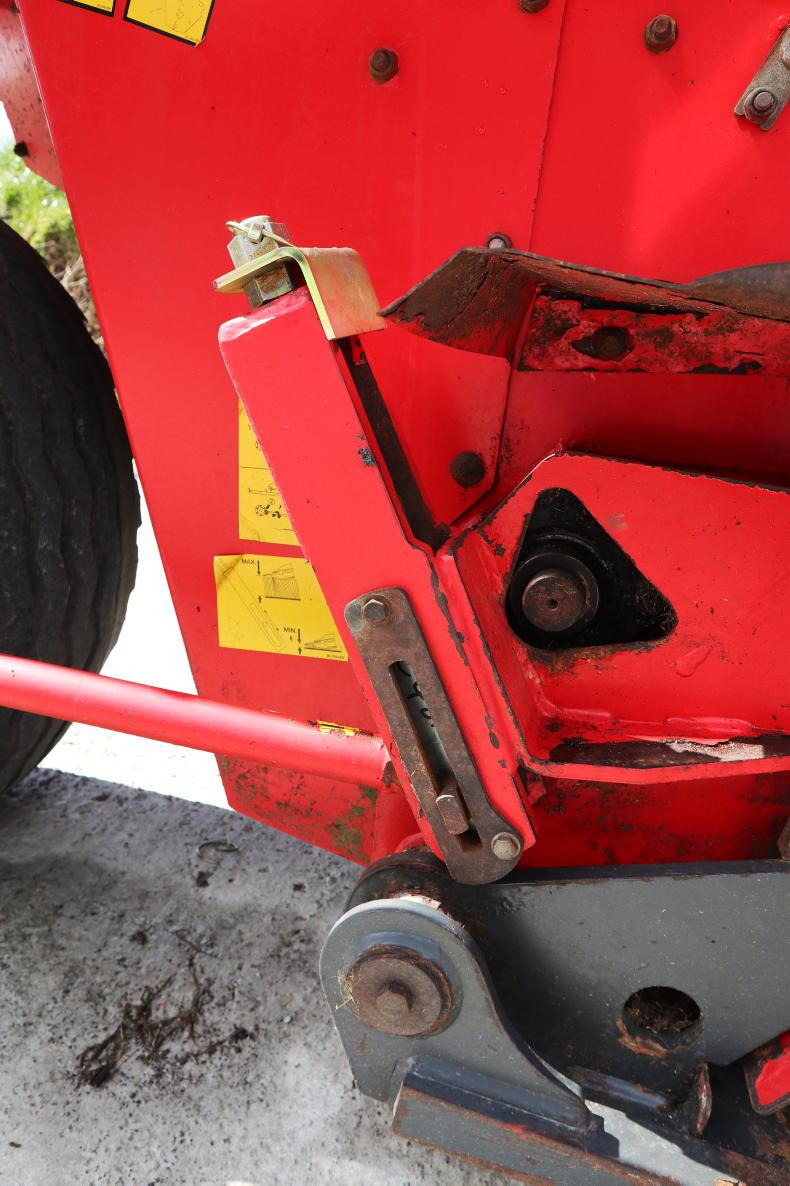
Check the height adjuster for wear in the threads.
Double-check the tension on the main springs. The tension should be set in the field and the mower should be able to follow undulating ground. Different operators will have varied preferred cutting heights.
6 General
The PTO should always be checked over. Check to ensure the crosses remain tight. It is important from a safety perspective that the drive shaft has a good functional cover. The mower cover is the first line of defence if an obstacle flies so it is essential to maintain and repair, if damaged.

Tyre condition should be inspected while wheel bearings and studs should be checked over.
The rams, hydraulic hoses and fittings should be checked over for leaks, corrosion and damage. Likewise, the lights should be checked regularly.
Tyre condition should be inspected while wheel bearings and studs should be checked over.
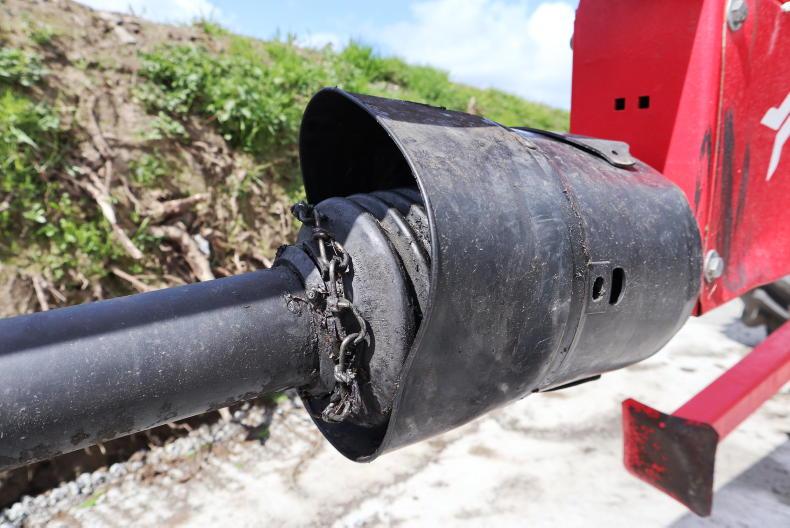
It’s important from a safety perspective that the drive shaft has a good functional cover.
A well-maintained mower can be the difference between a largely hassle-free silage season or one spent running over and back to the local dealer.
We travelled to Clonbern in Co Galway to catch up with Patrick Dolan and Derek Raftery of P&D Agri Services at their new premises and get some tips for getting your trailed mower ready for the silage season.
The firm is an independent Case IH, New Holland and Kverneland specialist so many of the tips offered in this piece refer to Kverneland mowers, but most advice applies to all mowers.

Patrick Dolan (left) and Derek Raftery of P&D Agri Services.
1 Visual inspection
First off, the team would encourage a general walk around the mower to check for any issues and damage. Look closely for any leaks.
You may spot a small bit of weeping where oil might have started leaking over the winter. It is important to seal up these leaks before any oil is changed. Likewise, all oil levels should be checked over before the oil is changed.

The hydraulic hoses and fittings should be checked over for leaks, corrosion and damage.
If any of the oil levels are low, you need to ask yourself why. If all the oil levels are OK, the mower should be run for a short period. While running, a walk around and careful listen will help to flag and any initial issues.
Check over the slip clutch. Make sure it hasn’t seized over winter, and that it can be taken apart. Make sure the discs are not stuck to the steel. They can be sanded down and cleaned, but if the discs are black or burnt, replace them.

The slip clutch can be taken apart and the discs sanded down and cleaned, but if the discs are black or burnt, replace them.
2 Change oil
Change oil when it is hot. Check the oil for the presence of filings. If there are no filings present, refill as normal.
If there is a small amount of grit or filing in the oil, the team at P&D would advise flushing out the bed. This involves refilling the bed with an oil and diesel mixture and running it for a few minutes to loosen up any grit. It should easily flow out of the sump better than synthetic oil.

Change the oils when they are hot and check the oil for the presence of filings.
If there are excessive filings or grit in the system, the bed will need to be stripped down and power-washed. Grit is usually an indication of trouble with bearings.
Each mower and brand will vary but the lads fill a typical 10ft Kverneland mower bed with 4.1l of oil and a 9ft Kverneland mower with 3.6l of oil. They use GL75-90 gear oil.
It is very important not to overfill the mower bed with oil. The bed has no breather like a gearbox has. If you overfill the bed it will cause excessive heat. The oil level in the mower bed varies greatly from brand to brand so always refer to the operator’s manual or local dealer before starting this task. The oil change intervals for the cutting bed also vary from brand to brand.
3 The bed
The hubs should be checked for excessive play. A rocking in the hub will indicate bearing trouble. Check the stone guards for wear. If excessively worn they should be changed, otherwise they will only fall off in time.
The middle section is very important as it also protects the bed, especially in the case of a blade bending backwards. Stone guards are priced in the region of €85 to €107 plus VAT each.

Rotate or replace damaged or worn blades as necessary.
The discs should be checked to ensure they are not excessively damaged or have chunks missing off them. They can be exposed to rock damage and wear so it is important to check them regularly.
Damaged discs may cause a vibration in the mower. Running a mower at such speed with vibrations will lead to further damage. Ensure the top hats are securely bolted on. Rotate or replace damaged or worn blades as necessary.
Finally, check over the bolts on the hangers that hold the bed on to the mower frame. It is held using five bolts each side. Check that the bolts are in good condition and are tight.
4 Conditioner
Firstly, check the condition of the two rotor bearings. The team at P&D say you will often find wire caught around these bearings. If the seal is damaged it is a tell-tale sign the bearing needs to be replaced. Also, if any rocking or play is evident, they will need to be changed. Make sure all the tines are present on the conditioner and none are bent or damaged.

Make sure all the tines are present on the conditioner and none are bent or damaged.
Also, check for damaged or cracked hangers. If any hangers or tines are missing it will cause the rotor to run off balance and create unwanted vibration. Check the state of conditioner belts. If the belts are anyway hard or cracked, replace them. Otherwise, they won’t last very long when the pressure comes on.
5 Cutting at the correct height
Check the height adjuster for wear in the threads. Sometimes, the roll pin in the threaded bar can also break, meaning the bar will freely thread up and down but the cutting angle won’t change.

Check the height adjuster for wear in the threads.
Double-check the tension on the main springs. The tension should be set in the field and the mower should be able to follow undulating ground. Different operators will have varied preferred cutting heights.
6 General
The PTO should always be checked over. Check to ensure the crosses remain tight. It is important from a safety perspective that the drive shaft has a good functional cover. The mower cover is the first line of defence if an obstacle flies so it is essential to maintain and repair, if damaged.

Tyre condition should be inspected while wheel bearings and studs should be checked over.
The rams, hydraulic hoses and fittings should be checked over for leaks, corrosion and damage. Likewise, the lights should be checked regularly.
Tyre condition should be inspected while wheel bearings and studs should be checked over.

It’s important from a safety perspective that the drive shaft has a good functional cover.















 This is a subscriber-only article
This is a subscriber-only article









SHARING OPTIONS: